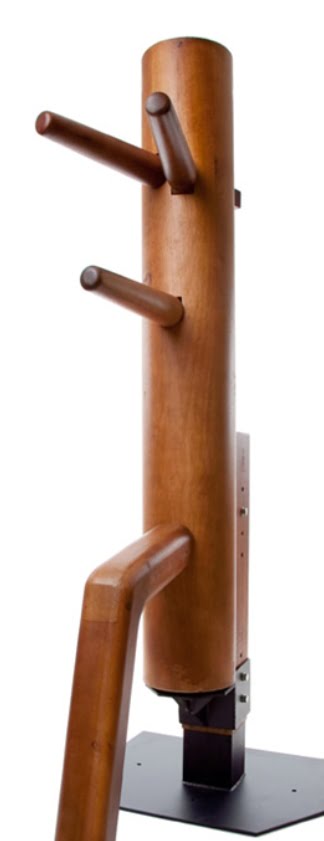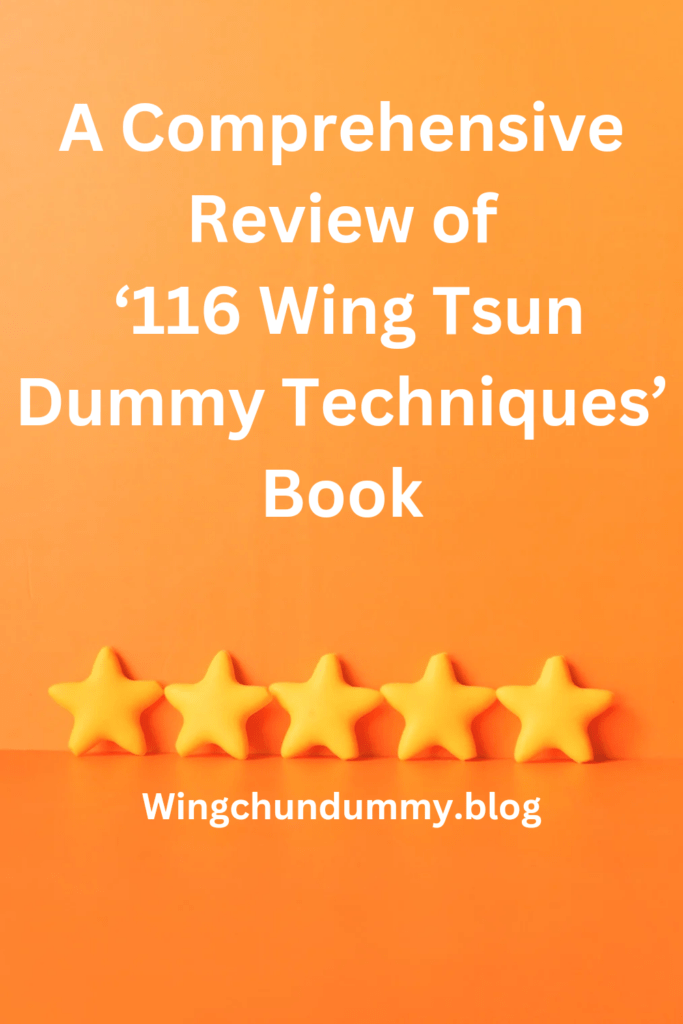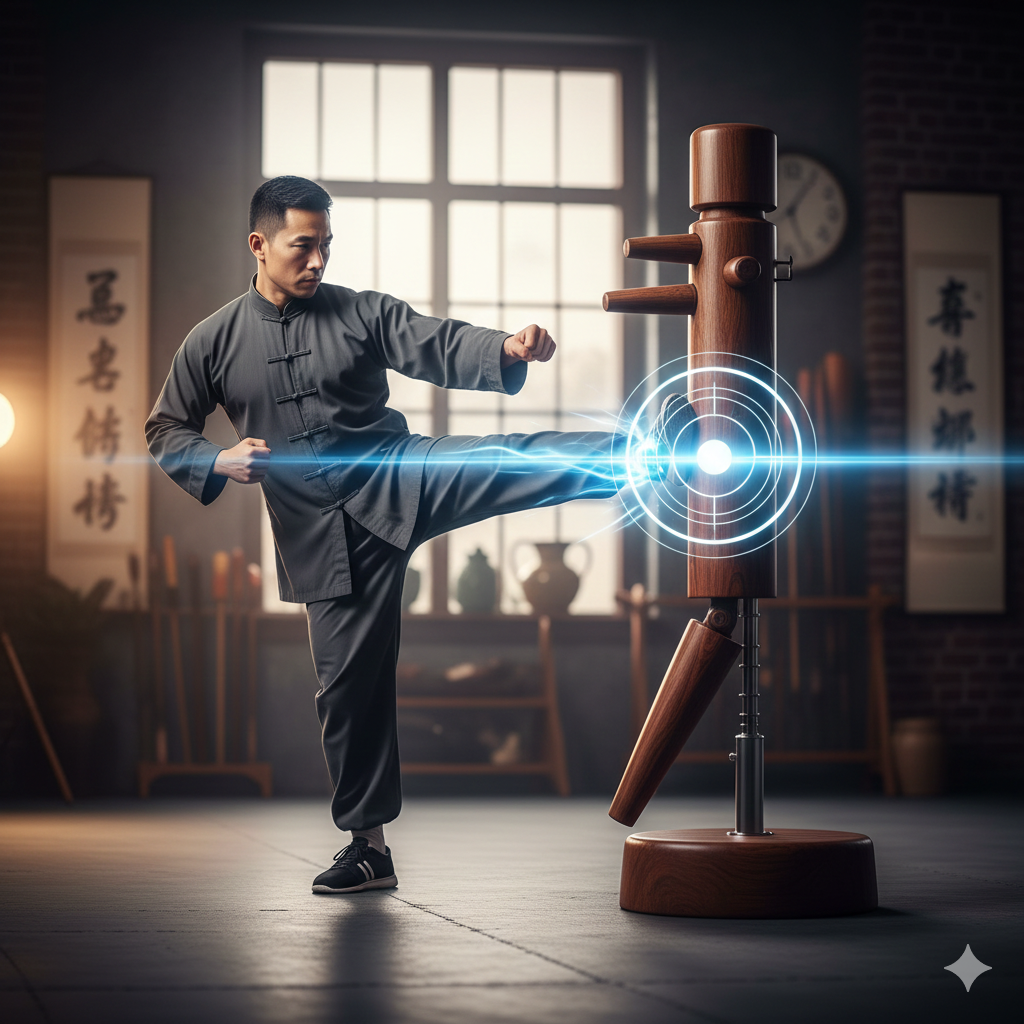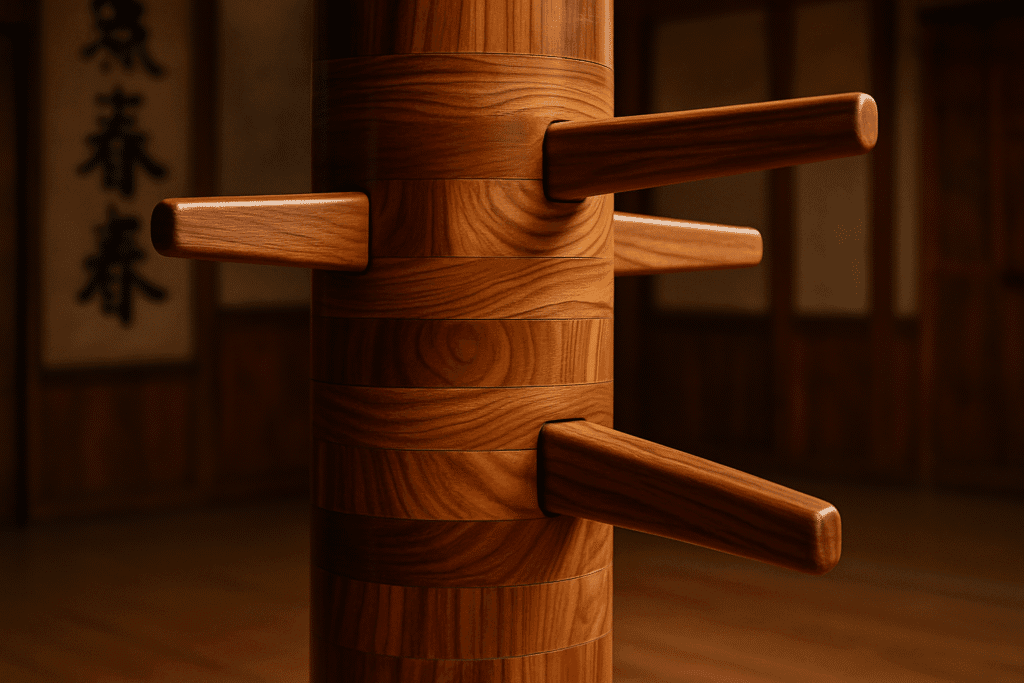Wing Tsun, a traditional Southern Chinese martial art, is renowned for its efficiency and practicality in self-defense.
Originating in the Qing Dynasty, Wing Tsun was developed by the legendary Ng Mui, a Buddhist nun, and was later refined by her student, Yim Wing Chun.
The martial art is distinguished by its emphasis on close-range combat, direct and economical movements.
And the principle of redirecting an opponent’s force rather than meeting it head-on.
The historical development of Wing Tsun is closely intertwined with the secret societies and anti-Qing movements of the time.
Its techniques were passed down through generations in a clandestine manner, ensuring that the art remained an effective means of self-defense against oppression.
Notable practitioners such as Ip Man, Bruce Lee, and Leung Ting have played pivotal roles in popularizing Wing Tsun globally, each contributing to its evolution and widespread recognition.
A key component of Wing Tsun technique is the use of the wooden dummy, or muk yan jong.
This training apparatus, consisting of a wooden frame with protruding arms and a leg, is instrumental in refining a practitioner’s techniques.
Through repetitive practice on the wooden dummy, students can develop precision, speed, and power in their movements while also enhancing their structural integrity and body mechanics.
The wooden dummy serves as a surrogate opponent, allowing practitioners to practice and perfect complex sequences of movements in a controlled environment.
It aids in the development of muscle memory, enabling students to execute techniques instinctively during real-life encounters.
Moreover, the dummy helps in honing the practitioner’s sensitivity to force and pressure, which are crucial aspects of Wing Tsun’s defensive strategies.
In summary, Wing Tsun’s rich historical background and its practical approach to self-defense have solidified its place as a respected martial art.
The integration of the wooden dummy in training is a testament to the art’s emphasis on continuous improvement and mastery of techniques.
As we delve into ‘116 Wing Tsun Dummy Techniques,’ it becomes evident that the wooden dummy is not merely a training tool but a cornerstone of Wing Tsun practice, encapsulating the essence of this martial art.
About the Author: A Master’s Perspective
The author of ‘116 Wing Tsun Dummy Techniques,’ a distinguished and revered figure in the martial arts community, boasts a rich history of dedication and mastery in Wing Tsun.
With decades of training and teaching experience, the author has earned numerous accolades and titles, positioning themselves as a leading authority in the discipline.
Their journey began at an early age, under the tutelage of renowned masters, which laid the foundation for a lifelong commitment to the art.
In addition to their hands-on practice, the author has contributed significantly to the academic and practical knowledge of Wing Tsun.

They have conducted seminars worldwide, sharing their expertise and passion with a diverse audience.
Their ability to break down complex techniques into accessible and understandable concepts has been a hallmark of their teaching style, making them a sought-after mentor for both novice and advanced practitioners.
The author’s deep understanding of Wing Tsun is evident in their meticulous approach to the ‘116 Wing Tsun Dummy Techniques.’
Each technique is not merely demonstrated but is also contextualized within the broader philosophy and strategy of Wing Tsun.
This comprehensive perspective is invaluable for readers, offering insights that extend beyond mere physical movements to encompass the principles and mindset that underpin effective practice.
Furthermore, the author’s contributions to martial arts literature have been widely recognized.
Their works are frequently cited in academic and training circles, underscoring their influence and authority.
Their experience is not limited to Wing Tsun; they have also explored and integrated elements from other martial arts, enriching their understanding and teaching of Wing Tsun.
For readers and practitioners, the author’s perspective offers a unique blend of tradition and innovation.
Their extensive background, coupled with a forward-thinking approach, ensures that ‘116 Wing Tsun Dummy Techniques’ is not just a manual but a comprehensive guide that resonates with both the historical roots and contemporary practice of Wing Tsun.
Book Structure and Layout
The book “116 Wing Tsun Dummy Techniques” is meticulously structured to cater to both novices and advanced practitioners of Wing Tsun.
The content is organized into coherent chapters, each focusing on a specific aspect of the wooden dummy techniques.
This logical progression aids in the reader’s comprehension and ensures that the learning process is methodical and thorough.
The chapters are well-defined, starting from basic movements and gradually advancing to more complex techniques, making it accessible for practitioners at different skill levels.
Each chapter is supplemented with detailed illustrations and photographs that vividly depict the techniques being discussed.
These visuals are crucial for understanding the precise movements and positions required in Wing Tsun training.
The clarity of these illustrations is commendable, as they leave little room for ambiguity, ensuring that readers can follow along with ease.
The inclusion of multiple angles and step-by-step sequences in the photographs further enhances the learning experience.
The instructions provided in the book are clear and concise, making it easier for readers to grasp the nuances of each technique.
The author has taken great care to break down complex movements into simple steps, which significantly aids in the reader’s comprehension.
Whether the reader is a novice just starting with Wing Tsun or an advanced practitioner looking to refine their skills, the instructions are articulated in a manner that is easy to follow and understand.
From a readability standpoint, the book excels in maintaining a neutral tone that is both formal and engaging.
The language used is precise, avoiding unnecessary jargon that could confuse beginners while still being informative for seasoned practitioners.
Overall, the structure and layout of “116 Wing Tsun Dummy Techniques” make it a valuable resource for anyone looking to deepen their understanding of Wing Tsun through well-organized and clearly presented content.
Key Concepts and Techniques Explained
“116 Wing Tsun Dummy Techniques” meticulously dissects the intricate art of Wing Tsun, a traditional Chinese martial arts system.
The book serves as a comprehensive guide, elucidating the 116 distinct techniques that form the cornerstone of the Wing Tsun Dummy training.
At the heart of the book is the concept of the ‘Muk Yan Jong’ or Wooden Dummy, an essential training apparatus in Wing Tsun.
The dummy represents a human opponent, allowing you to perfect the techniques in a controlled environment.
The 116 techniques enhance your ability to
- generate power,
- maintain balance,
- and optimize angles of attack and defense.
One of the key principles highlighted is ‘Lat Sau Jik Chung’, or ‘intercepting force’, which emphasizes the importance of direct and efficient responses to an opponent’s actions.
Techniques such as ‘Bong Sau’ (Wing Arm) and ‘Tan Sau’ (Palm-Up Arm) are exemplified to demonstrate this principle.

These movements teach practitioners how to deflect incoming force while simultaneously positioning themselves for a counterattack.
Another significant concept is ‘Yiu Ma’, or ‘waist and stance’, which underscores the necessity of a strong and stable foundation.
‘Chum Kiu’ (Sinking Bridge)
and ‘Biu Jee’ (Thrusting Fingers)
Illustrating how proper stance and waist movement can enhance both offensive and defensive capabilities.
These techniques not only improve physical attributes but also instill a deeper understanding of Wing Tsun’s strategic framework.
The book also delves into the application of these techniques in real-world scenarios.
Offering insights on how to adapt and modify movements based on situational demands.
Through detailed illustrations and step-by-step instructions, “116 Wing Tsun Dummy Techniques”.
Provides a thorough exploration of the methodology and philosophy that underpin the Wing Tsun system,
Making it an invaluable resource for both novice and experienced martial artists.
Practical in Self-Defense
The ‘116 Wing Tsun Dummy Techniques’ book delves deeply into the practical applications of its teachings in real-life self-defense situations.
One of the core principles of Wing Tsun is its focus on using an opponent’s energy and force against them, making it particularly effective for individuals of varying strength and size.
For instance, the book emphasizes the importance of close-range combat, which is a common scenario in street altercations.
Techniques such as the ‘Pak Sau’ (slapping hand) and ‘Lop Sau’ (grabbing hand) are highlighted for their ability to neutralize an opponent’s attack swiftly.
By mastering these moves, a practitioner can deflect or control an aggressor’s limbs, creating opportunities for counter-attacks.
Another practical technique discussed is the ‘Chi Sau’ (sticky hands) drill,
It enhances sensitivity and reflexes.
This drill trains practitioners to maintain constant contact with an opponent.
Allow you to feel and react to changes in pressure and movement instantaneously.
In a self-defense context, this heightened sensitivity can be the difference between evading a strike and sustaining an injury.
The book also addresses the psychological aspects of self-defense.
Such as situational awareness and the importance of maintaining a calm, focused mindset.
You experience that Techniques are presented within scenarios that mimic real-life encounters.
For instance defending against multiple attackers or dealing with weapons.
For example, the ‘Bong Sau’ (wing arm) – knife attack, etc.
In summary, ‘116 Wing Tsun Dummy Techniques’ offers a comprehensive guide to applying Wing Tsun principles in self-defense.
You will find the effectiveness of the technique.
It Provide value of skills that you can us in different high-risk situations.
Whether one is a seasoned martial artist or a beginner.
The strategies outlined in this book can significantly enhance one’s ability to protect themselves effectively.
Training Tips and Best Practices
Integrating the teachings from the ‘116 Wing Tsun Dummy Techniques’ book into your regular training regimen can significantly enhance your Wing Tsun practice.
The wooden dummy, an essential tool in Wing Tsun.
Offers numerous benefits when used correctly.
Here are several tips and best practices to help you incorporate these techniques effectively and maximize your training outcomes.
First and foremost, consistency is key.
Regular practice with the wooden dummy allows you to internalize the movements and develop muscle memory.
Allocate specific time slots in your training schedule dedicated solely to dummy practice.
This focused approach ensures that you progressively build on your skills without neglecting other aspects of your training.
While practicing, pay close attention to your form and posture.
And incorrect posture can lead to inefficiencies in technique and potential injury.
Keep your shoulders relaxed, maintain a stable stance,
This not only helps in developing power but also in maintaining balance and stability.
Another crucial aspect is to practice with mindfulness.
Instead of rushing through the techniques.
Take your time to understand the mechanics behind each movement.
The ‘116 Wing Tsun Dummy Techniques’ book provides detailed explanations and illustrations that can guide you.
Use these resources to dissect each technique, understand its purpose, and execute it with intent.
Mindful practice enhances your ability to adapt and apply these techniques in real-life scenarios.
Common mistakes like over-reliance on brute force or neglecting footwork can hinder your progress.
Remember that Wing Tsun emphasizes efficiency and fluidity.
Focus on the precision of your movements rather than the intensity.
Incorporate footwork drills alongside dummy practice to ensure a holistic approach to skill development.
Lastly, seek feedback and make adjustments.
Training with partners or under the supervision of an experienced instructor can provide valuable insights into your form and technique.
Constructive feedback allows you to identify areas of improvement and refine your practice.
By adhering to these training tips and best practices.
You can effectively incorporate the teachings from the ‘116 Wing Tsun Dummy Techniques’ book into your routine.
Thereby enhancing your overall Wing Tsun proficiency.
When examining the ‘116 Wing Tsun Dummy Techniques’ book,
it’s beneficial to compare it with other notable Wing Tsun resources to appreciate its unique contributions fully.
Among such resources are Leung Ting’s ‘Wing Tsun Kuen’ and Wong Shun Leung’s ‘Wing Chun:
The Science of In-Fighting.’ Each of these works offers distinct perspectives and training methodologies.
Adding depth to the study of Wing Tsun.
Give you a comprehensive insights into the principles and techniques of Wing Tsun.
It covers various aspects, from basic stances and movements to advanced combat strategies.
In comparison, ‘116 Wing Tsun Dummy Techniques’ focuses specifically on the wooden dummy forms.
Providing a detailed breakdown of each technique.
This focus allows practitioners to delve deeply into the nuances of wooden dummy training,
Wong Shun Leung’s ‘Wing Chun:
The Science of In-Fighting’ emphasizes the practical application of Wing Tsun techniques in real-life combat scenarios.
His approach is pragmatic, highlighting efficiency and effectiveness in self-defense.
While ‘116 Wing Tsun Dummy Techniques’
Also addresses the application of techniques.
its primary contribution lies in its methodical breakdown of dummy forms,
offering a structured approach to mastering these essential movements.
Another notable comparison is with the ‘Wing Chun Compendium’ by Wayne Belonoha,
which provides an encyclopedic overview of Wing Tsun principles, forms, and applications.
The ‘116 Wing Tsun Dummy Techniques’ book complements this broader approach by zeroing in on the wooden dummy form.

Providing a specialized resource that enhances a practitioner’s overall understanding and skill set.
In essence, while each of these resources enriches the Wing Tsun literature in its own right,
‘116 Wing Tsun Dummy Techniques’ stands out for its in-depth focus on the wooden dummy.
This specificity makes it an invaluable addition for practitioners seeking to refine their technique and deepen their understanding of this crucial training apparatus.
Conclusion and Final Thoughts
The book ‘116 Wing Tsun Dummy Techniques’ provides an in-depth exploration of the Wing Tsun system.
Focusing particularly on the wooden dummy techniques.
Throughout our review, we have highlighted the book’s comprehensive nature.
Which skillfully covers both the theoretical and practical aspects of the martial art.
The detailed illustrations and step-by-step instructions make it an invaluable resource for practitioners at various levels.
One of the key strengths of the book lies in its ability to break down complex techniques into understandable segments.

This makes it extremely accessible for beginners who are just starting their journey in Wing Tsun.
The text are clear with high-quality images that provide visual clarity.
Ensuring that readers can easily follow along.
Furthermore, the book delves into the philosophy behind each movement.
Offering a deeper understanding that goes beyond mere physical execution.
Advanced practitioners will find the nuanced discussions of technique variations particularly beneficial.
The book doesn’t just present a one-size-fits-all solution but instead encourages the reader to think critically about their own practice.
This makes it a versatile guide that can adapt to individual needs and skill levels.
For Wing Tsun instructors, ‘116 Wing Tsun Dummy Techniques’ serves as an excellent teaching aid.
The structured approach allows instructors to systematically introduce concepts to their students, ensuring a well-rounded education in the art.
The book also provides insights into common mistakes and how to correct them, which can be crucial for effective teaching.
However, one potential weakness is that the book assumes a certain level of prior knowledge about Wing Tsun.
Complete novices may find some sections challenging without additional instructional support.
Despite this, the book’s strengths far outweigh this minor drawback.
In conclusion, ‘116 Wing Tsun Dummy Techniques’ is a must-read for anyone serious about mastering Wing Tsun.
Its comprehensive and detailed approach makes it suitable for beginners, advanced practitioners, and instructors alike.
This book stands as a testament to the richness of Wing Tsun and is an essential addition to any martial artist’s library.



